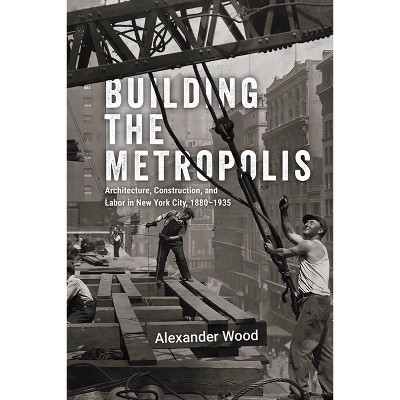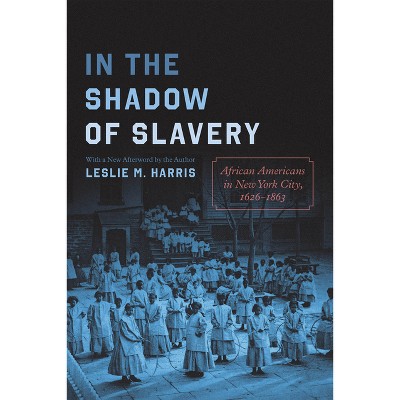Sponsored

Demolition Means Progress - (Historical Studies of Urban America) by Andrew R Highsmith (Paperback)
$32.00
In Stock
Eligible for registries and wish lists
Sponsored
About this item
Highlights
- In 1997, after General Motors shuttered a massive complex of factories in the gritty industrial city of Flint, Michigan, signs were placed around the empty facility reading, "Demolition Means Progress," suggesting that the struggling metropolis could not move forward to greatness until the old plants met the wrecking ball.
- About the Author: Andrew R. Highsmith is assistant professor of history at the University of California, Irvine.
- 398 Pages
- History, United States
- Series Name: Historical Studies of Urban America
Description
About the Book
Flint, Michigan, is widely seen as Detroit s Detroit: the perfect embodiment of a ruined industrial economy and a shattered American dream. In this deeply researched book, Andrew Highsmith gives us the first full-scale history of Flint, showing that the Vehicle City has always seen demolition as a tool of progress. During the 1930s, officials hoped to renew the city by remaking its public schools into racially segregated community centers. After the war, federal officials and developers sought to strengthen the region by building subdivisions in Flint s segregated suburbs, while GM executives and municipal officials demolished urban factories and rebuilt them outside the city. City leaders later launched a plan to replace black neighborhoods with a freeway and new factories. Each of these campaigns, Highsmith argues, yielded an ever more impoverished city and a more racially divided metropolis. By intertwining histories of racial segregation, mass suburbanization, and industrial decline, Highsmith gives us a deeply unsettling look at urban-industrial America."Book Synopsis
In 1997, after General Motors shuttered a massive complex of factories in the gritty industrial city of Flint, Michigan, signs were placed around the empty facility reading, "Demolition Means Progress," suggesting that the struggling metropolis could not move forward to greatness until the old plants met the wrecking ball. Much more than a trite corporate slogan, the phrase encapsulates the operating ethos of the nation's metropolitan leadership from at least the 1930s to the present. Throughout, the leaders of Flint and other municipalities repeatedly tried to revitalize their communities by demolishing outdated and inefficient structures and institutions and overseeing numerous urban renewal campaigns--many of which yielded only more impoverished and more divided metropolises. After decades of these efforts, the dawn of the twenty-first century found Flint one of the most racially segregated and economically polarized metropolitan areas in the nation. In one of the most comprehensive works yet written on the history of inequality and metropolitan development in modern America, Andrew R. Highsmith uses the case of Flint to explain how the perennial quest for urban renewal--even more than white flight, corporate abandonment, and other forces--contributed to mass suburbanization, racial and economic division, deindustrialization, and political fragmentation. Challenging much of the conventional wisdom about structural inequality and the roots of the nation's "urban crisis," Demolition Means Progress shows in vivid detail how public policies and programs designed to revitalize the Flint area ultimately led to the hardening of social divisions.Review Quotes
"Demolition Means Progress excels in delineating truth from fiction by viewing Flint's modern history in the context of local, state and national history over the past century."-- "East Village Magazine"
"Demolition Means Progress testifies to the continued vibrancy of urban history and its remapping of how we understand the twentieth-century United States. In a book bursting with ideas and fresh insights, Highsmith rethinks de jure and de facto racial segregation, creates a new vocabulary for suburban, metropolitan, and regional forms of capitalism, and brilliantly narrates the entire arc of twentieth-century American industrialization at the scale of a single city, Flint, Michigan, and its suburbs. A remarkable book."-- "Robert Self, author of American Babylon: Race and the Struggle for Postwar Oakland"
"For decades in the twentieth century, Flint, Michigan, produced millions of the latest model General Motors cars, as well as made itself into a model of another kind: a metropolitan area whose relentless pursuit of a more prosperous future came at the price of growing racial segregation, economic inequality, and political fragmentation. Highsmith is a wonderful guide through the tragic interplay of deindustrialization, suburbanization, and disinvestment that unfolded in America's industrial heartland. His is a deeply local story with enormous national significance."-- "Lizabeth Cohen, author of A Consumers' Republic: The Politics of Mass Consumption in Postwar America"
"Highsmith delivers a wide-ranging exploration of the Herculean efforts to create a prosperous, thriving metropolis--and the inequalities produced by these efforts. . . .Historians of Midwestern cities will find much of value in Demolition Means Progress."-- "H-Midwest"
"Highsmith skillfully defines not just what was considered 'progress' but how its realization extended a long pattern of physical improvements at high cost to collective social welfare. Focusing especially on ways race prejudice defined life in the Vehicle City and its environs, Highsmith provides a multilayered analysis to support his contention that urban misfortunes and racial injustice have been intimately connected in the modern-era North. While the contours of Highsmith's account of efforts to revitalize Flint are familiar in a broad sense, his examination of how racial discrimination factored into every stage of the city's modern history is unusually detailed and convincing."-- "American Historical Review"
"Highsmith's brilliant book is a sweeping case study that traces the policies and decisions that contributed to the rise and fall of Flint, Michigan, over the course of the twentieth century."-- "History of Education Quarterly"
"If you wonder why there is so much anger in the African-American communities of the US today, you should read Highsmith's book. It is a primer on the bad things done to black people who dared to pursue the American dream. . . . Liberals will find Highsmith's account particularly harrowing because the road to hell in Flint was often paved with good intentions. The policies of Franklin Roosevelt's New Deal, for example, helped lay the foundation for persistent residential segregation of the city and its suburbs."-- "Financial Times"
"In this captivating examination of corporate capitalism, urban renewal, and metropolitan fortune, Andrew R. Highsmith unpacks the mythology of the de facto versus de jure segregation binary. In its place, he proposes a tripartite framework of legal, administrative, and popular segregation that destructively shaped the twentieth-century metropolitan landscape. . . . In part by enlarging our vocabulary, he also demonstrates the relevance of a metropolitan, versus regional, lens to the discourse of deindustrialization. Highsmith's careful parsing of the forms of segregation reveals this practice's insidious and enduring reach."-- "Journal of American History"
"In this sobering new book Highsmith tracks the fall of Flint, Michigan, once one of the nation's greatest industrial towns, now one of its poorest cities. But this isn't just another story of urban decay. It's a compelling analysis of institutional injustice wrapped in the promise of revitalization, a powerful history of exclusion and destruction in the name of progress."-- "Kevin Boyle, author of Arc of Justice: A Saga of Race, Civil Rights and Murder in the Jazz Age"
"Powerful. . . . Demolition Means Progress is a story of how people--in this case, the founding fathers of Flint's white suburbs--used municipal government as a weapon, drawing borders of citizenship to exclude people of color and the poor from the region's wealth. That's a story that played out in metropolitan areas across America in the decades after World War II. But it was particularly devastating in Flint."-- "In These Times"
"The economic crises of the ensuing decades--in their utter devastation--seem almost the end of urban history. It is one signal contribution of Demolition Means Progress, though, that we might see that history as a tortuous path of missed opportunities and bold, though often shortsighted, attempts at revitalization. It is another that the book ends with a timely reminder that Flint is not dead, as residents and civic leaders continue their quest for revitalization, even behind dauntingly fortified walls of racial segregation and inequality."-- "Pacific Historical Review"
"Using the case study of Flint, Michigan, from the mid-20th century to the present, this ambitious effort to rethink US urban history is a strong work that will be of considerable value to students and scholars of US urban history, urban studies, and urban planning, as well as general readers interested in urban life in the US. . . . [He] presents a new typology of segregation as it has played out in Flint, moving beyond the concepts of de facto and de jure segregation to those of legal, administrative, and popular segregation, which he argues have greater explanatory power. Also insightful are the ongoing efforts by city residents and leaders to improve and revitalize the city in the face of the strong forces noted above, which have negatively impacted the city over the past half century. A useful epilogue brings readers up to date with relevant developments in Flint since the turn of the twenty-first century. Recommended."-- "Choice"
"While individual threads of Highsmith's interlocking narratives of suburbanization, racial segregation, and deindustrialization seem at first blush familiar to urban historians, this work is notable for its comprehensive, metropolitan approach and for adding a small-city case study to the literature on urban renewal and decline. With chronological chapters focusing on Flint's housing and education policies, workplace discrimination, industrial decentralization, and slum clearance, Highsmith provides a fine-grained analysis of how economic and racial inequality in American cities is spatialized and planned from the federal to municipal levels."-- "Michigan Historical Review"
About the Author
Andrew R. Highsmith is assistant professor of history at the University of California, Irvine.Dimensions (Overall): 9.0 Inches (H) x 6.0 Inches (W) x .82 Inches (D)
Weight: 1.17 Pounds
Suggested Age: 22 Years and Up
Number of Pages: 398
Genre: History
Sub-Genre: United States
Series Title: Historical Studies of Urban America
Publisher: University of Chicago Press
Theme: State & Local
Format: Paperback
Author: Andrew R Highsmith
Language: English
Street Date: December 30, 2016
TCIN: 1006093890
UPC: 9780226419558
Item Number (DPCI): 247-35-1841
Origin: Made in the USA or Imported
If the item details aren’t accurate or complete, we want to know about it.
Shipping details
Estimated ship dimensions: 0.82 inches length x 6 inches width x 9 inches height
Estimated ship weight: 1.17 pounds
We regret that this item cannot be shipped to PO Boxes.
This item cannot be shipped to the following locations: American Samoa (see also separate entry under AS), Guam (see also separate entry under GU), Northern Mariana Islands, Puerto Rico (see also separate entry under PR), United States Minor Outlying Islands, Virgin Islands, U.S., APO/FPO
Return details
This item can be returned to any Target store or Target.com.
This item must be returned within 90 days of the date it was purchased in store, shipped, delivered by a Shipt shopper, or made ready for pickup.
See the return policy for complete information.











